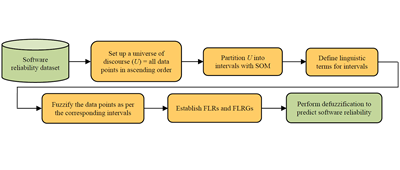SOM-FTS: A Hybrid Model for Software Reliability Prediction and MCDM-Based Evaluation
DOI:
https://doi.org/10.46604/ijeti.2022.8546Keywords:
software reliability, multi-criteria decision making, WSM, TOPSIS, EDASAbstract
The objective of this study is to propose a hybrid model based on self-organized maps (SOM) and fuzzy time series (FTS) for predicting the reliability of software systems. The proposed SOM-FTS model is compared with eleven traditional machine learning-based models. The problem of selecting a suitable software reliability prediction model is represented as a multi-criteria decision-making (MCDM) problem. Twelve software reliability prediction models, including the proposed SOM-FTS model, are evaluated using three MCDM methods, four performance measures, and three software failure datasets. The results show that the proposed SOM-FTS model is the most suitable model among the twelve software reliability prediction models on the basis of MCDM ranking.
References
A. Iannino, et al., “Software Reliability,” Advances in Computers, vol. 30, pp. 85-170, 1990.
H. Pham, System Software Reliability, London: Springer, 2006.
M. Bisi, et al., “Software Development Efforts Prediction Using Artificial Neural Network,” IET Software, vol. 10, no. 3, pp. 63-71, June 2016.
M. Bisi, et al., “Prediction of Software Inter-Failure Times Using Artificial Neural Network and Particle Swarm Optimisation Models,” International Journal of Software Engineering, Technology, and Applications, vol. 1, no. 2-4, pp. 222-244, 2015.
P. Roy, et al., “Forecasting of Software Reliability Using Neighborhood Fuzzy Particle Swarm Optimization Based Novel Neural Network,” IEEE/CAA Journal of Automatica Sinica, vol. 6, no. 6, pp. 1365-1383, November 2019.
P. Rani, et al., “A Neuro-Particle Swarm Optimization Logistic Model Fitting Algorithm for Software Reliability Analysis,” Proceedings of the Institution of Mechanical Engineers, Part O: Journal of Risk and Reliability, vol. 233, no. 6, pp. 958-971, 2019.
J. Wang, et al., “Software Reliability Prediction Using a Deep Learning Model Based on the RNN Encoder-Decoder,” Reliability Engineering and System Safety, vol. 170, pp. 73-82, February 2018.
G. Jabeen, et al., “An Improved Software Reliability Prediction Model by Using High Precision Error Iterative Analysis Method,” Software Testing, Verification, and Reliability, vol. 29, no. 6-7, Article no. e1710, 2019.
L. Zhen, et al., “Parameter Estimation of Software Reliability Model and Prediction Based on Hybrid Wolf Pack Algorithm and Particle Swarm Optimization,” IEEE Access, vol. 8, pp. 29354-29369, 2020.
S. Kassaymeh, et al., “Salp Swarm Optimizer for Modeling Software Reliability Prediction Problems,” Neural Processing Letters, vol. 53, no. 6, pp. 4451-4487, December 2021.
P. F. Pai, et al., “Software Reliability Forecasting by Support Vector Machines with Simulated Annealing Algorithms,” Journal of Systems and Software, vol. 79, no. 6, pp. 747-755, June 2006.
J. Lou, et al., “Software Reliability Prediction via Relevance Vector Regression,” Neurocomputing, vol. 186, pp. 66-73, April 2016.
H. Zhang, et al., “Applying Software Metrics to RNN for Early Reliability Evaluation,” Journal of Control Science and Engineering, vol. 2020, Article no. 8814394, 2020.
B. Mohammed, et al., “Failure Prediction Using Machine Learning in a Virtualised HPC System and Application,” Cluster Computing, vol. 22, no. 2, pp. 471-485, 2019.
A. Kumar, et al., “A Hybrid SOM-Fuzzy Time Series (SOMFTS) Technique for Future Forecasting of COVID-19 Cases and MCDM Based Evaluation of COVID-19 Forecasting Models,” International Conference on Computing, Communication, and Intelligent Systems, pp. 612-617, February 2021.
A. Kaur, et al., “Statistical Comparison of Modelling Methods for Software Maintainability Prediction,” International Journal of Software Engineering and Knowledge Engineering, vol. 23, no. 6, pp. 743-774, August 2013.
P. Singh, “Rainfall and Financial Forecasting Using Fuzzy Time Series and Neural Networks Based Model,” International Journal of Machine Learning and Cybernetics, vol. 9, no. 3, pp. 491-506, 2018.
Q. Song, et al., “Forecasting Enrollments with Fuzzy Time Series—Part I,” Fuzzy Sets and Systems, vol. 54, no. 1, pp. 1-9, 1993.
S. M. Chen, “Forecasting Enrollments Based on Fuzzy Time Series,” Fuzzy Sets and Systems, vol. 81, no. 3, pp. 311-319, 1996.
H. K. Yu, “Weighted Fuzzy Time Series Models for TAIEX Forecasting,” Physica A: Statistical Mechanics and Its Applications, vol. 349, no. 3-4, pp. 609-624, April 2005.
C. H. Cheng, et al., “Forecasting Innovation Diffusion of Products Using Trend-Weighted Fuzzy Time-Series Model,” Expert Systems with Applications, vol. 36, no. 2, pp. 1826-1832, March 2009.
R. Efendi, et al., “Improved Weight Fuzzy Time Series as Used in the Exchange Rates Forecasting of US Dollar to Ringgit Malaysia,” International Journal of Computational Intelligence and Applications, vol. 12, no. 1, Article no. 1350005, March 2013.
W. C. S. Hong, Principal Concepts in Applied Evolutionary Computation: Emerging Trends, Hershey: IGI Global, 2012.
R. K. Iyer, et al., “Measurement-Based Analysis of Software Reliability,” https://www.cse.cuhk.edu.hk/~lyu/book/reliability/pdf/Chap_8.pdf, 1996.
P. C. Fishburn, “Additive Utilities with Incomplete Product Sets: Application to Priorities and Assignments,” Operations Research, vol. 15, no. 3, pp. 537-542, 1967.
C. L. Hwang, et al., Multiple Attribute Decision Making, Berlin: Springer Berlin Heidelberg, 1981.
M. K. Ghorabaee, et al., “Multi-Criteria Inventory Classification Using a New Method of Evaluation Based on Distance from Average Solution (EDAS),” Informatica, vol. 26, no. 3, pp. 435-451, Januray 2015.
D. A. Dickey, et al., “Distribution of the Estimators for Autoregressive Time Series with a Unit Root,” Journal of the American Statistical Association, vol. 74, no. 366, pp. 427-431, June 1979.
C. Kocak, et al., “A New Fuzzy Time Series Method Based on an ARMA-Type Recurrent Pi-Sigma Artificial Neural Network,” Soft Computing, vol. 24, no. 11, pp. 8243-8252, June 2020.

Published
How to Cite
Issue
Section
License
Copyright Notice
Submission of a manuscript implies: that the work described has not been published before that it is not under consideration for publication elsewhere; that if and when the manuscript is accepted for publication. Authors can retain copyright in their articles with no restrictions. Also, author can post the final, peer-reviewed manuscript version (postprint) to any repository or website.

Since Jan. 01, 2019, IJETI will publish new articles with Creative Commons Attribution Non-Commercial License, under Creative Commons Attribution Non-Commercial 4.0 International (CC BY-NC 4.0) License.
The Creative Commons Attribution Non-Commercial (CC-BY-NC) License permits use, distribution and reproduction in any medium, provided the original work is properly cited and is not used for commercial purposes.







.jpg)


